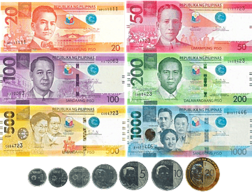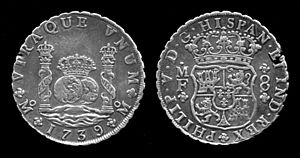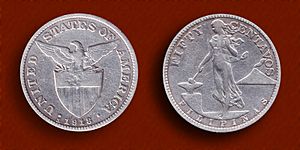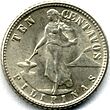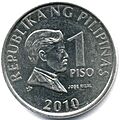Philippine peso facts for kids
The Philippine peso, also called piso in Filipino, is the official money of the Philippines. It is divided into 100 smaller units called sentimo or centavos.
The peso uses the symbol "₱". This symbol was first used during American rule. Before that, the "$" symbol was common, like in other Spanish-speaking countries. You might also see "PHP", "PhP", "Php", or just "P" used for the peso.
The Bangko Sentral ng Pilipinas (BSP) is the central bank of the Philippines. It was started on July 3, 1993. The BSP is in charge of making the country's banknotes (paper money) and coins. They make these at their Security Plant Complex.
Quick facts for kids Philippine peso |
|||
|---|---|---|---|
|
|||
| ISO 4217 Code | PHP | ||
| User(s) | |||
| Inflation | 3.8% | ||
| Source | Philippine Statistics Authority, April 2024 | ||
| Method | CPI | ||
| Subunit | |||
| 1⁄100 | sentimo (or centavo) | ||
| Symbol | ₱ | ||
| Coins | |||
| Freq. used | 5¢, 25¢, ₱1, ₱5, ₱10, ₱20 | ||
| Rarely used | 1¢ | ||
| Banknotes | |||
| Freq. used | ₱20, ₱50, ₱100, ₱200, ₱500, ₱1000 | ||
| Printer | The Security Plant Complex | ||
| This article contains Unicode currency signs. Without the correct software, you may see question marks, boxes, or other symbols instead of currency signs. |
Contents
The History of Philippine Money
The Philippine peso comes from the Spanish peso. These were also known as "pieces of eight." Spanish ships called Manila galleons brought many of these coins from Spanish America between the 1500s and 1800s. Other countries like the US, Hong Kong, China, and Japan also got their money names (dollar, yuan, yen) from the same Spanish peso.
Money Before Spanish Rule
Before the Spanish arrived, people in the Philippines traded goods using a system called barter. This meant exchanging items directly, like rice for tools. But barter could be difficult.
Over time, people started using certain items as money. Gold was common in many parts of the islands. Small gold pieces called Piloncitos were used. These are thought to be the earliest coins in the Philippines. Gold rings were also used for trade.
The word salapi is an old Tagalog word for money, still used today. It might come from the word for "one rupya" (an old Indian coin). Another word, pera, might come from the Malay word perak, meaning "silver."
Spanish Colonial Period Money
The Spanish dollar (a silver coin worth eight reales) first came to the Philippines with the Magellan expedition in 1521. More were brought after the Spanish took control in 1565.
The first silver coins were rough-cut pieces called macuquinas. Later, machine-made coins called Columnarios (or "pillar dollars") were introduced in 1732. These coins were made of silver.
To make smaller change, people would sometimes cut the Spanish dollar coins into eight pieces. Each piece was worth one Spanish real. Local copper coins called cuartos or barrillas were also made. This is where the Filipino words kwarta (money) and barya (coin or loose change) come from.
Money was often hard to find in Manila. When there was a lot, it was sent to other provinces or exported to pay for goods. In 1857, a rule said that money should be counted in pesos and céntimos (1/100 of a peso). But this was confusing because the copper cuartos were worth 1/160 of a peso.
Money in the 19th Century
The Spanish gold onza (a large gold coin) was worth 16 silver pesos. This meant the peso could be valued in either silver or gold. This caused problems because the value of gold and silver changed in international trade.
Later, importing Mexican pesos was stopped in 1877. Only older Mexican pesos were considered equal to Philippine pesos. The Philippine peso became a "fiat coin," meaning its value was set by the government, not by the metal it contained.
The first money printing house in the Philippines, the Casa de Moneda de Manila, opened in 1857. It started making gold peso coins in 1861 and silver céntimo coins in 1864.
In 1897, Spain introduced new 1-peso silver coins and smaller céntimo coins. These Spanish-Filipino pesos were used until 1904. Then, American authorities replaced them with new US-Philippine pesos.
The first paper money in the Philippines was the Philippine peso fuerte. It was issued in 1851 by the first bank in the country, El Banco Español Filipino de Isabel II.
Money During the Revolution
After the Philippines declared independence on June 12, 1898, the Philippine Republic, led by General Emilio Aguinaldo, made its own coins and paper money. These were supported by the country's natural resources. These coins were the first to use the name centavo instead of céntimo. After Aguinaldo was captured in 1901, this revolutionary money stopped being used.
American Colonial Period Money
When the United States took over the Philippines, they passed the Philippine Coinage Act of 1903. This law set the value of the Philippine peso to half of a U.S. dollar. This link to the U.S. dollar lasted until the Philippines became independent in 1946.
The law allowed for silver pesos to be made, similar to the Mexican peso. These were worth 50 cents in gold. It also allowed for smaller coins and silver certificates (paper money backed by silver). A special fund was created to keep the peso's value stable.
The US government also made special coins for the Culion leper colony between 1913 and 1930.
Commonwealth Period Money
In 1935, when the Philippines became a U.S. Commonwealth, the coat of arms on the back of the coins changed. It showed a smaller eagle over a shield, with "Commonwealth of the Philippines" written below.
World War II and Money
During World War II, when Japan invaded, US-Philippine forces tried to save most of the gold and money from Manila's banks. They even threw about ₱15 million worth of silver pesos into the sea rather than let the Japanese get them. After the war, much of this money was returned or recovered.
The Japanese occupiers printed their own paper money, which quickly lost its value. People also used "guerrilla pesos," which were emergency notes printed by local governments. The Japanese government made it illegal to have guerrilla money. This led to hyperinflation, meaning prices went up very, very quickly.
US and Philippine forces also kept printing pesos. After October 1944, all earlier money, except the guerrilla notes, was no longer legal.
Independence and the Central Bank of the Philippines (1949–1993)
On January 3, 1949, the Central Bank of the Philippines (CBP) was created. This bank took over all power to print and make Philippine money. Before this, other banks like the Bank of the Philippine Islands could also issue money.
After the war, the Philippines faced problems like slow farming, needing to import many goods, and high inflation. The CBP tried to keep the peso's value fixed at ₱2 per U.S. dollar. This helped improve trade, but it also led to a black market where dollars were traded for more than ₱3.
By 1962, it was too hard to keep the ₱2 per dollar rate. So, the government allowed the peso's value to float more freely. The exchange rate changed to ₱3.90 per dollar in 1965. This helped attract foreign investments. However, because the Philippines didn't make enough of its own goods, this change also caused prices to rise. By 1970, another change was needed, and the rate became ₱6.43 per dollar.
In 1967, coins started using Filipino words instead of English. Banknotes followed in 1969. So, "centavo" became sentimo, and "peso" became piso. However, many Filipinos still commonly use "centavo."
From 1970 to 1993, the CBP used a "managed float system." This meant they didn't have a fixed exchange rate but tried to keep the market stable. It was still hard to control inflation and keep exchange rates steady. In the 1980s, a crisis caused the exchange rate to almost double, from ₱11 to ₱20 per dollar, and prices also doubled.
The New Bangko Sentral ng Pilipinas
In 1993, a new law created the new Bangko Sentral ng Pilipinas (BSP). Its main job is to keep prices stable. The new BSP is independent from the government, which helps it do its job better. This also led to the peso having a "fully floating exchange rate system." This means the market now decides the peso's value against other currencies.
Since then, the peso's value against the U.S. dollar has changed. It was between ₱24–46 from 1993 to 1999, ₱40–56 from 2000 to 2009, and ₱40–54 from 2010 to 2019.
Names for Different Money Values
The smallest unit of Philippine money is called centavo in English. After 1967, it became officially known as sentimo in Filipino. However, many Filipinos still use "centavo" or its local spellings like síntabo and sentabo.
In the past, Tagalog words were common for different centavo coins:
- The half-centavo coin was called kusing.
- The 1-centavo coin was called isang pera or sampera.
- Coins for 5, 10, 25, and 50 centavos were called by their Spanish names: singko, diyes, bentesingko, and singkwenta. The 50-centavo coin was also called salapi.
Coins of the Philippines
The first coin factory in the Philippines, the Casa de Moneda de Manila, opened in 1857. It made silver coins (10, 20, 50 céntimos) and gold coins (1, 2, 4 pesos).
The American government made coins for the Philippines in the U.S. starting in 1903. These included half-centavo, one-centavo, five-centavo coins, and silver 10, 20, 50 centavos, and 1 peso. The Manila Mint reopened in 1920 to make coins in the Philippines.
In 1937, the design on the back of the coins changed to the coat of arms of the Commonwealth of the Philippines. No coins were made during World War II (1942-1943). Coin making started again in 1944-45.
In 1958, the new English coinage series was introduced. These coins were made of different metals: bronze (1 centavo), brass (5 centavos), and nickel-brass (10, 25, 50 centavos). The 20-centavo coin was stopped.
In 1967, the Pilipino-language coin series came out. The names changed to piso and sentimo. This series included aluminum (1 sentimo), brass (5 sentimo), and nickel-brass (10, 25, 50 sentimo) coins. The 1-piso coin returned in 1972.
In 1975, the Ang Bagong Lipunan Series was introduced. It had aluminum (1 sentimo), brass (5 sentimo), cupro-nickel (10, 25 sentimo, 1 piso), and a pure nickel 5-piso coin.
In 1983, the Flora and Fauna Series was released. It included aluminum (1, 5, 10 sentimo), brass (25 sentimo), and cupro-nickel (50 sentimo, 1 piso, and a new 2-piso coin). From 1991 to 1994, the sizes of some coins were made smaller. A new nickel-brass 5-piso coin was also added.
In 1995, the New Design coin series was introduced. It aimed to replace all older coins. It started with copper-plated steel (1, 5, 10 sentimo), brass (25 sentimo), copper-nickel (1 piso), and nickel-brass (5 piso). In 2000, a two-metal 10-piso coin was added.
The current series, the New Generation Currency Series, came out in 2017. It has nickel-plated steel coins for 1, 5, 25 sentimo, and 1, 5, 10 piso. In December 2019, a new two-metal 20-piso coin was introduced. A new nine-sided 5-piso coin was also made because the old round one looked too much like the 1-piso and 10-piso coins.
Coins worth P0.25 and less are still made but are not used as much. Some people have suggested stopping these smaller coins, but the government has said no.
| Value | Obverse | Reverse | Diameter | Mass | Thickness | Composition | Edge | Obverse Design | Reverse Design | Introduced |
|---|---|---|---|---|---|---|---|---|---|---|
| 1-sentimo | 15 mm | 1.90 g | 1.54 mm | Nickel-plated steel | Plain | "Republika ng Pilipinas"; Three stars and the sun (like the Philippine flag); Value; Year of minting; Mint mark | Xanthostemon verdugonianus (Mangkono tree); logo of the Bangko Sentral ng Pilipinas | March 26, 2018 | ||
| 5-sentimo | 16 mm | 2.20 g | 1.60 mm | Reeded | Hoya pubicalyx (Kapal-kapal Baging plant); logo of the Bangko Sentral ng Pilipinas | March 26, 2018 | ||||
| 25-sentimo |  |
 |
20 mm | 3.60 g | 1.65 mm | Plain | Dillenia philippinensis (Katmon fruit tree); logo of the Bangko Sentral ng Pilipinas | March 26, 2018 | ||
| 1-piso |  |
 |
23 mm | 6.00 g | 2.05 mm | Segmented (Plain and Reeded edges) | "Republika ng Pilipinas"; Portrait of José Rizal; Value; Year of minting; Mint mark | Vanda sanderiana (Waling-waling orchid); logo of the Bangko Sentral ng Pilipinas | March 26, 2018 | |
| 5-piso |  |
 |
25 mm | 7.40 g | 2.20 mm | Plain | "Republika ng Pilipinas"; Portrait of Andrés Bonifacio; Value; Microprint of "Republika ng Pilipinas"; Year of minting; Mint mark | Strongylodon macrobotrys (Tayabak flower); logo of the Bangko Sentral ng Pilipinas; Microprint of "Bangko Sentral ng Pilipinas" | November 30, 2017 | |
| 5-piso (nonagonal shape) |  |
 |
25 mm | 7.40 g | 2.20 mm | December 17, 2019 | ||||
| 10-piso |  |
 |
27 mm | 8.00 g | 2.05 mm | Reeded with edge inscription of "BANGKO SENTRAL NG PILIPINAS" in italics | "Republika ng Pilipinas"; Portrait of Apolinario Mabini; Value; Microprint of "Republika ng Pilipinas"; Year of minting; Mint mark | Medinilla magnifica (Kapa-kapa plant); logo of the Bangko Sentral ng Pilipinas; Microprint of "Bangko Sentral ng Pilipinas"; Microdots | March 26, 2018 | |
| 20-piso |  |
 |
30 mm | 11.50 g | 2.10 mm | Ring: bronze-plated steel; Center: nickel-plated steel | Plain edge with inscription of "BSP" at six angles | Ring: "Republika ng Pilipinas"; Center: Portrait of Manuel Quezon; Value; Microprint of "Republika ng Pilipinas"; Year of minting; Mint mark | Scyphiphora hydrophylacea (Nilad plant); logo of the Bangko Sentral ng Pilipinas; Malacañang Palace; Microprint of "Bangko Sentral ng Pilipinas" | December 17, 2019 |
Banknotes of the Philippines
Older Banknote Series
In 1852, the first Philippine banknotes were issued by El Banco Español Filipino de Isabel II. These were in values of 10, 25, 50, and 200 pesos fuertes.
By 1903, the American government issued Silver Certificates. These were backed by silver coins or U.S. gold. Other banks also issued banknotes. After Philippine independence in 1946, only the Treasury Certificates remained legal.
The size of Philippine banknotes (16 x 6.6 cm) has been the same since the American rule. This size was so successful that the U.S. even changed the size of their own banknotes to be similar.
In 1949, the Central Bank of the Philippines (CBP) took over printing money. Their first notes were old Treasury Certificates with "Victory - Central Bank of the Philippines" printed on them. Then, in 1951, the regular English Series banknotes were released. These included values from 5 centavos up to 500 pesos. The centavo notes stopped being made in 1958 when new coins were introduced.
In 1967, the CBP started using the Filipino language on its Pilipino Banknote Series. The bank's name became Bangko Sentral ng Pilipinas. In 1969, the Pilipino Series notes were introduced, including 1, 5, 10, 20, 50, and 100 piso. The Ang Bagong Lipunan Series came out in 1973 and added 2-piso notes.
A big change happened in 1985 with the New Design Series. This series introduced 500-piso notes in 1987, 1000-piso notes in 1991 (for the first time), and 200-piso notes in 2002.
The New Design Series was later called the BSP Series after the Bangko Sentral ng Pilipinas was re-established in 1993. This series was replaced by the New Generation Currency Series in 2010. The New Design/BSP Series banknotes were printed until 2013. They were legal to use until December 31, 2015, and could be exchanged until December 29, 2017. After that date, they were no longer valid.
New Generation Currency (Current Banknotes)
In 2009, the Bangko Sentral ng Pilipinas (BSP) announced a major redesign for banknotes and coins. The goal was to make them safer and last longer. The new designs feature famous Filipinos and beautiful natural places in the Philippines. Philippine national symbols are on the coins. The first new banknotes were released in December 2010.
Some small errors were found on the first New Generation series banknotes. For example, Batanes was missing from the Philippine map on the back of all notes. The Puerto Princesa Underground River and the Tubbataha Reef were shown in the wrong places on some notes. Also, the colors on the blue-naped parrot on the 500-peso note were not quite right. These issues were later fixed in newer printings.
In February 2016, the BSP started circulating new 100-peso notes with a stronger violet color. This was to make them easier to tell apart from the 1000-peso notes. Older 100-peso notes with lighter colors are still accepted.
In 2019, the BSP introduced a 20-piso coin. This coin will eventually replace the 20-piso banknote. The banknote will slowly disappear as old ones wear out.
| Value | Image | Dimensions | Main Color | Design | Year of First Issue | Usage in circulation | |||
|---|---|---|---|---|---|---|---|---|---|
| Obverse | Reverse | Obverse | Reverse | ||||||
| 20-piso | 160 mm × 66 mm | Orange | Manuel L. Quezon, Declaration of Filipino as the national language, Malacañang Palace | Banaue Rice Terraces; Paradoxurus hermaphroditus (Asian palm civet); Cordilleras weave design | December 16, 2010 | To be replaced by coin | |||
| 50-piso | Red | Sergio Osmeña, First Philippine Assembly, Leyte Landing October 1944 | Taal Lake in Batangas; Caranx ignobilis, maliputo (giant trevally fish); Batangas embroidery design | Wide | |||||
| 100-piso | Violet | Manuel A. Roxas, Old Bangko Sentral ng Pilipinas (BSP) building in Intramuros, Manila, Inauguration of the Third Philippine Republic | Mayon Volcano in Albay; butanding, Rhincodon typus, whale shark; Bicol textile design | ||||||
| 200-piso | Green | Diosdado P. Macapagal, EDSA People Power 2001, Declaration of Philippine Independence 1898 in Kawit, Cavite, opening of Malolos Congress at Barasoain Church‚ Bulacan | Chocolate Hills in Bohol; Tarsius syrichta, Philippine tarsier; Visayas weave design | ||||||
| 500-piso | Yellow | Corazon C. Aquino, Benigno S. Aquino Jr., EDSA People Power I, Benigno Aquino monument in Makati | Subterranean Underground River in Puerto Princesa, Palawan; Tanygnathus lucionensis, blue-naped parrot; Southern Philippines cloth design | ||||||
| 1,000-piso | Light Blue | José Abad Santos, Vicente Lim, Josefa Llanes Escoda; Centennial celebration of Philippine independence; Medal of Honor | Tubbataha Reefs Natural Park in Sulu Sea; Pinctada maxima, South Sea pearl; Mindanao design for T'nalak (Ikat-dyed abaca) | ||||||
| For table standards, see the banknote specification table. | |||||||||
Special Commemorative Banknotes
The Bangko Sentral ng Pilipinas sometimes issues special banknotes to remember important historical events. These can be:
- Regular banknotes with a special print on them.
- Specially printed, higher-value banknotes that are not for everyday use.
Some examples of these special banknotes include:
- 2,000-piso and 100,000-piso notes for the 100th anniversary of Philippine Independence in 1998.
- A 5,000-piso note for the 2021 Quincentennial Commemorations in the Philippines.
How Money is Managed: Monetary Policy
The Bangko Sentral ng Pilipinas (BSP) is the central bank of the Philippines. It started in 1993. Its main goal is to keep prices low and stable. This helps the economy grow in a balanced and steady way.
The BSP does this by "inflation targeting." This means they announce a target for how much prices should go up (inflation) over two years. Then, they use different tools to reach this target:
- They change the interest rate at which they lend to banks.
- They buy or sell government bonds to control how much money is in circulation.
- They offer special deposits to banks to take money out of the system.
- They provide money to banks if needed.
- They can change how much money banks must keep in reserve.
If prices are going up too fast (inflation is too high), the BSP will use a "contractionary policy." This means they will try to reduce the amount of money in circulation. They might raise interest rates or sell government bonds. If prices are too low, they might do the opposite to encourage spending.
Peso Exchange Rates
Historical Exchange Rates
From 1946 to 1962, the official exchange rate was ₱2 for every U.S. dollar. In 1962, it changed to ₱3.90, and in 1970, it changed again to ₱6.43. During these times, the "black market" rate was often higher than the official rate.
The peso's value continued to change over the years. For example, it went from ₱11.25 per dollar in 1983 to ₱18 in 1984. In the 1990s, it reached ₱28. During the 1997 Asian financial crisis, the peso dropped from ₱26 in July 1997 to ₱45 in 1998, and then to about ₱50 in 2001. It then got stronger, reaching ₱41 in 2007.
In the 2010s, it was ₱40 in 2012, then weakened to ₱54 per dollar in 2018. During the COVID-19 pandemic, the peso became stronger, reaching ₱47 in 2021. In 2022, it reached its lowest point ever, ₱59.203 per dollar. This was likely due to the economic effects of the war in Ukraine. Today, official exchange rates show the true value of the peso, so there are no longer black markets for currency.
Current Exchange Rate
| Current PHP exchange rates | |
|---|---|
| From Google Finance: | AUD CAD CHF EUR GBP HKD JPY USD |
| From Yahoo! Finance: | AUD CAD CHF EUR GBP HKD JPY USD |
| From XE.com: | AUD CAD CHF EUR GBP HKD JPY USD |
| From OANDA: | AUD CAD CHF EUR GBP HKD JPY USD |
| From fxtop.com: | AUD CAD CHF EUR GBP HKD JPY USD |
Recent Money Issues
Errors in Currency Printing
In 2005, about 78 million 100-peso notes were printed with President Gloria Macapagal Arroyo's last name spelled incorrectly as "Arrovo." Only after 2 million notes were in use was the mistake found. The BSP started an investigation.
The way scientific names were printed on the 2010 New Generation Currency Series notes was also incorrect. These errors were fixed in 2017.
In December 2017, a 100-peso banknote was issued that had no face of Manuel A. Roxas and no "100" watermark. The BSP said this was a rare printing mistake.
1-Peso Coin Problems
Around 2006, people found out that the Philippine 1-peso coin was the same size as the 1 United Arab Emirates dirham coin. Since 1 peso was worth much less than 1 dirham, some people used 1-peso coins in vending machines in the UAE to trick them.
Fake Money
In 2017, a 1-peso coin supposedly from 1971 appeared. It claimed to have a design from Jose Rizal's novel on the back. Some people tried to sell it for a lot of money. However, the BSP confirmed that they never made such a coin. They also said the coin was thinner than real ones, suggesting it had been changed by someone.
In June 2018, a picture of a fake ₱10,000 note spread online. It showed President Ramon Magsaysay on the front. The Bangko Sentral ng Pilipinas quickly stated that this banknote was fake. They reminded everyone that only 20, 50, 100, 200, 500, and 1,000 peso notes are real.
Folded Banknotes
In July 2022, a person posted online about a slightly folded ₱1,000 polymer banknote that was rejected by a mall. This caused worry among people. However, both the mall and the BSP later released statements saying that folded polymer notes are still accepted.
See also
 In Spanish: Peso filipino para niños
In Spanish: Peso filipino para niños
- Economy of the Philippines
Images for kids


